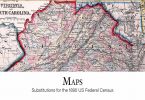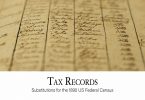Are you frustrated by the absence of the 1890 US federal census? A lot of genealogists are, particularly beginner genealogists, for whom the census is one of the first genealogical tools most of them learn how to use. It leaves a gap of twenty years in the genealogical record for the 1890 census to be gone. It means from 1880 to 1900, you do not know what your family was doing. The good news is that there are other records you can use to fill in the gaps left by this missing census. Land records are one of them.
Ever since there have been civilizations, there have been land records. Some of the earliest of ancient records we have are land records (along with tax records). We know the names of plenty of people who would otherwise have been long lost to history because their names appear on land records from ancient times. We may not know anything else about them, but we know they bought or owned land in ancient Egypt, Greece, Sumer, Mesopotamia, Babylon, and more. In a way, it gives these people a little bit of immortality.
The way land records work is a similar-in fact, almost identical—in modern times. When someone buys land from the government or from a private individual, a deed or bill of sale is generated, and it is usually filled with a government entity. Some land records were kept in private hands, but they were usually filed with a government of some kind. You can use land records to find out who lived where and when, who bought land from whom, and to trace the ownership of a piece of land through decades, and even centuries. This information is of great assistance to genealogists.
Especially during the 1880 to 1900 gap, there are a lot of American land records available that might be particularly helpful for you in bridging the 1890 census gap. This was the era of homesteading when the US federal government was selling land for cheap to people who were willing to work it and improve it for five years. In fact, the land could be theirs for free if they stayed on it, worked it, and improved it for the allotted period of time. Lots of people took the government upon the homesteading offer. Those records are readily available from the US Bureau of Land Management.
In fact, the Bureau of Land Management has a website where you can order these records. Of course, you need to find out first if your ancestor was a homesteader. Luckily, there is a database of names and states (with the names cross-referenced) on that website. This makes it easy for you to check for ancestors who may have been homesteaders, and then to order their homesteading record from the website.
Land records can also be found in wills, at local courthouses, at local archives, and on some genealogy websites. Make use of them. They may be just the key you need to jump across the gap left by the 1890 US federal census.






